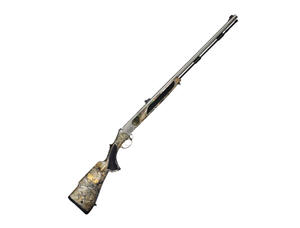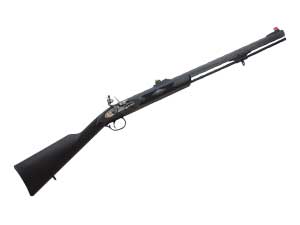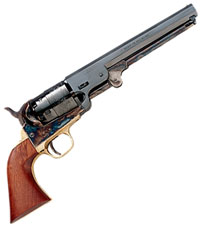
As whitetail deer populations continue to soar in many parts of the North, East and South, often near populated areas, more and more jurisdictions are adding primitive-weapons-only seasons. Out West, most States offer muzzleloader-only tags for elk and mule deer that are often much easier to obtain than modern rifle tags in the same areas. As a result, savvy hunters across the nation are taking up muzzleloader hunting in order to take advantage of these enhanced hunting opportunities. Other hunters are simply attracted to the added challenge that these short-range, single-shot weapons provide. Still others enjoy using traditional weapons for Civil War re-enactments or just collecting them as a hobby. Whatever your interests, here is what you need to know to get started in the world of muzzleloaders.
Muzzleloader Rifles — Modern Design
 |
| Modern muzzleloaders are available with the latest synthetic stocks, including thumbhole designs and camouflage finishes. |
The first thing you will notice when browsing a website or catalogue is that most of these "primitive" weapons don't look that primitive at all, and certainly don't look like what Daniel Boone might have carried. You are, in fact, looking at the modern, "in-line" muzzleloader. While "traditional" muzzleloaders are still available, these modern versions account for the lion's share of today's market, and for good reason.
The biggest drawback of traditional style muzzleloaders, which we will also cover here, is that they can sometimes fail to fire under damp or wet conditions. This is not usually a problem with in-line muzzleloaders, and accuracy also tends to be significantly better.
All muzzleloaders share a common trait: as their name implies, they are loaded through the muzzle, rather than through the breech as with modern smokeless firearms. Both powder and projectile are pushed and poured down the barrel toward the breech, where the powder is ultimately ignited and burned, causing the projectile to be discharged down and out the barrel. Where the various types of muzzleloaders differ is in the means and location of the ignition.
"In-line" refers to the fact that the igniter is directly behind and in line with the powder charge, which results in more efficient ignition and, thereby, consistent energy and significantly more accuracy. These weapons are available in various action types, including bolt action, break action and lever or pivot action, and the biggest advantage that they all offer over traditional muzzleloaders is that their ignition systems are generally completely protected from the elements, promoting reliable ignition even under adverse hunting conditions.
Most of these muzzleloaders now use #209 shotgun shell or muzzleloader primers to ignite the powder charge. When the trigger is pulled, an external or internal hammer falls, or a plunger-type firing pin is released, striking the primer. These primers create much more spark than the caps used to ignite traditional muzzleloaders, also improving the reliability and efficiency of ignition. As an added bonus, most in-line muzzleloaders have removable breech plugs, allowing for quick and easy cleaning or removal of an unfired bullet and powder charge at the end of the hunting day. Many also feature premium triggers for enhanced accuracy. The vast majority of in-line muzzleloaders for big game hunting today are .50 caliber.
Many of these modern muzzleloaders are available with the latest synthetic stocks, including thumbhole designs and camouflage finishes, and with stainless-, nickel- or CeraKote-finished actions and fluted barrels.
You will notice that most in-line muzzleloaders have barrels indicating a rate of twist of 1-in-28 inches. This refers to the rifling in the barrel and how quickly one full turn is achieved. One-in-28 inches is a fast twist and is the optimum rate of twist for stabilizing the saboted bullets and other modern projectiles most commonly used in these guns. With these muzzleloaders and bullets, using fiber-optic sights or a scope (most in-lines come drilled and tapped for scope mounting), exceptional accuracy out to 150 yards or more is a reality.*
For the value conscious shooter or hunter, some in-line muzzleloaders are sold as a combo with a scope, or even as a starter kit with powder, bullets, tools and some cleaning equipment.
Traditional Design Muzzleloaders
Before the advent of in-line muzzleloaders in the mid 1980s, percussion or flintlock muzzleloaders were all that were available. Flintlocks, which date back to the Revolutionary War and are the most primitive type of muzzleloader available today, use a piece of flint on an external hammer to strike a steel plate, creating a spark that ignites a charge of very fine powder in a flash pan, which then ignites the main powder charge.
 |
| Flintlock muzzleloaders (above) and percussion muzzleloaders were all that were available before the advent of inline muzzleloaders in the mid 1980s. |
Percussion muzzleloaders, also known as caplocks, were invented around the time of the Civil War. They are similar to a flintlock, except the hammer strikes a nipple on which a musket cap or #11 percussion cap sits. The cap creates a spark which travels down through a hole in the nipple and into the powder charge.
Since flintlocks actually require the ignition and burning of two separate powder charges before the bullet is actually fired, they tend to have a bit slower "lock time" or firing time than percussions. They are also more prone to ignition problems due to moisture reaching the powder in the flash pan (hence the saying, "keep your powder dry").
When it comes to stocks and overall designs, most traditional muzzleloaders are either long-barreled and full-length stocked Pennsylvania or Kentucky rifles, or short-barreled and half-stocked Hawken or Plains rifles. In a mix of old and new, some Hawken styles are available with synthetic stocks and stainless barrels with fiber-optic sights, while do-it-yourselfers can choose from unfinished, build-it-yourself kits.
 |
| Traditions Trapper .50-Cal. Percussion and Flintlock Pistols |
In keeping with their more traditional roots, these smokepoles are most commonly used with either conical bullets or patched round balls. Accordingly, they typically sport 1-in-48 inch or 1-in-66 inch rate of twist octagonal barrels, which optimize the performance of each of these two types of projectiles, respectively.
Pistols
Single-shot in-line and traditional flintlock or percussion pistols in .50 caliber are basically miniature versions of their rifle cousins and are suitable for hunting deer or small game. In addition to these, various models of single-action revolvers, mostly in .44 caliber and shooting round balls, are a lot of fun to shoot and are popular with shooters looking to recreate a bit of Old West history. Revolvers with barrels of 7.5 to 12 inches are available in either Colt-style or Remington-style, with the main difference being that the Colts lack a top strap of steel over the cylinder. Starter kits with loading and cleaning tools and accessories offer good value. Colt-style revolvers are suitable for hunting deer or small game.
![]() Tip: Find the Traditions Trapper .50 caliber percussion and flintlock pistols at Cabelas.com here.
Tip: Find the Traditions Trapper .50 caliber percussion and flintlock pistols at Cabelas.com here.
 |
| Colt-style revolvers, like this one, are suitable for hunting deer or small game. |
A Word on Blackpowder
Although muzzleloaders have traditionally been loaded with black powder, many hunters and shooters today use black powder substitutes such as Blackhorn 209, Pyrodex or Triple Seven, particularly with in-line muzzleloaders. This is because these other powders are less corrosive and cause less fouling (thus requiring less cleaning) than black powder. In addition, some are available in convenient pre-formed and pre-measured pellets, with 50 grains being the most common weight. These pellets eliminate the need for measuring and pouring powder, thus greatly reducing the amount of time required to load or re-load.
Despite the advantages of these modern black powder substitutes, muzzleloaders must still be cleaned after every few shots. Be sure to follow the firearm and powder manufacturers' recommendations in that regard. In addition, some blackpowder substitutes may not be suitable for all muzzleloaders. Again, always follow the firearm and powder manufacturers' recommendations and warnings. Finally, never, EVER, use modern smokeless powder in a muzzleloader that was not designed for such use.
Make no mistake, today's modern replica muzzleloaders, especially in-line versions, are "primitive" weapons in name alone. You can now have many of the modern technological advantages of smokeless, centerfire cartridges and rifles, while still connecting with our shooting and frontier heritage. Enjoy.
*Some states have strict rules governing the use of scopes and the caliber and types of muzzleloaders, bullets and primers that can be used during special primitive weapons-only deer seasons. Be sure to check local regulations.
- 27694 views

